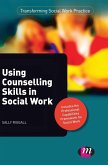Patricia Higham
Communication and Interviewing Skills for Practice in Social Work, Counselling and the Health Professions
Patricia Higham
Communication and Interviewing Skills for Practice in Social Work, Counselling and the Health Professions
- Gebundenes Buch
- Merkliste
- Auf die Merkliste
- Bewerten Bewerten
- Teilen
- Produkt teilen
- Produkterinnerung
- Produkterinnerung
This book supports and develops the communication and interviewing skills of professional practitioners and student practitioners in social work, counselling, and the health professions.
Andere Kunden interessierten sich auch für
![Interviewing for the Helping Professions Interviewing for the Helping Professions]() Fred R McKenzieInterviewing for the Helping Professions52,99 €
Fred R McKenzieInterviewing for the Helping Professions52,99 €![Systems Theory for Social Work and the Helping Professions Systems Theory for Social Work and the Helping Professions]() Werner SchirmerSystems Theory for Social Work and the Helping Professions179,99 €
Werner SchirmerSystems Theory for Social Work and the Helping Professions179,99 €![An Introduction to Using Theory in Social Work Practice An Introduction to Using Theory in Social Work Practice]() James A. ForteAn Introduction to Using Theory in Social Work Practice200,99 €
James A. ForteAn Introduction to Using Theory in Social Work Practice200,99 €![Using Counselling Skills in Social Work Using Counselling Skills in Social Work]() Sally RiggallUsing Counselling Skills in Social Work144,99 €
Sally RiggallUsing Counselling Skills in Social Work144,99 €![Understanding Phenomenological Reflective Practice in the Social and Ecological Fields Understanding Phenomenological Reflective Practice in the Social and Ecological Fields]() Peter WestobyUnderstanding Phenomenological Reflective Practice in the Social and Ecological Fields180,99 €
Peter WestobyUnderstanding Phenomenological Reflective Practice in the Social and Ecological Fields180,99 €![Working Ethically in Child Protection Working Ethically in Child Protection]() Bob LonneWorking Ethically in Child Protection228,99 €
Bob LonneWorking Ethically in Child Protection228,99 €![Working with Involuntary Clients Working with Involuntary Clients]() Chris TrotterWorking with Involuntary Clients179,99 €
Chris TrotterWorking with Involuntary Clients179,99 €-
-
-
This book supports and develops the communication and interviewing skills of professional practitioners and student practitioners in social work, counselling, and the health professions.
Produktdetails
- Produktdetails
- Verlag: Routledge
- Seitenzahl: 216
- Erscheinungstermin: 13. August 2019
- Englisch
- Abmessung: 260mm x 183mm x 16mm
- Gewicht: 610g
- ISBN-13: 9781138342934
- ISBN-10: 1138342939
- Artikelnr.: 57496643
- Herstellerkennzeichnung
- Libri GmbH
- Europaallee 1
- 36244 Bad Hersfeld
- gpsr@libri.de
- Verlag: Routledge
- Seitenzahl: 216
- Erscheinungstermin: 13. August 2019
- Englisch
- Abmessung: 260mm x 183mm x 16mm
- Gewicht: 610g
- ISBN-13: 9781138342934
- ISBN-10: 1138342939
- Artikelnr.: 57496643
- Herstellerkennzeichnung
- Libri GmbH
- Europaallee 1
- 36244 Bad Hersfeld
- gpsr@libri.de
Patricia Higham is a registered social worker and counsellor, and served as a non-executive director and lay member of NHS organisations in Nottinghamshire. She completed a BA degree at Wellesley College in Massachusetts, a postgraduate social work qualification at the University of Sheffield, a PhD at Cranfield University, and a part time counselling qualification over a three-year period. She is Professor of Social Work (emeritus) at Nottingham Trent University. She worked part time for the Quality Assurance Agency, Skills for Care, DeMontfort University, and for the Health and Care Professions Council. Her experience includes statutory social work in Sheffield, Milton Keynes, Northamptonshire, and mental health outreach in a rural area of Pennsylvania, USA. She is a life member of the British Association of Social Workers and a member of the National Association of Social Workers, USA. She is a member of the British Association of Counselling and Psychotherapy. She volunteers as a counsellor two days a week for charities that support women who experience domestic violence.
Acknowledgements
Chapter 1: Introducing Communication and Interviewing Skills
Chapter 2: The Person
Chapter 3: The Professional Practitioner
Chapter 4: Different Communication Approaches as Essential Tools of Practice
Chapter 5: Interviewing Skills
Chapter 6: A Conceptual Basis for Communicating and Interviewing in Different Practice Situations
Chapter 7: Information Giving as a Form of Communication
Chapter 8: Ethical Concerns for Communication and Interviewing
Chapter 9: Communication and Interviewing in Different Organisational Contexts
Chapter 10: Communicating with Technology, Computers, and Artificial Intelligence
Chapter 11: Communication in Different Practice Situations, Including People in Crisis, or with Mental Illness, Autism, Diabetes, Addictions, or Obesity
Chapter 12: Communicating in Situations of Loss
Chapter 13: Domestic Violence and Communication
Chapter 14: Communicating with Life Stories and Biographical approaches
Chapter 15: Communicating with Older People
Chapter 16: Communicating with People with Physical impairments, Learning Difficulties, and/or Anxiety and Depression
Chapter 17: Communicating with Children and Young People
Chapter 18: Professional Development to Improve Communication and Interviewing Skills
Chapter 19: Summarising the Book's Content and Themes
Index
Chapter 1: Introducing Communication and Interviewing Skills
Chapter 2: The Person
Chapter 3: The Professional Practitioner
Chapter 4: Different Communication Approaches as Essential Tools of Practice
Chapter 5: Interviewing Skills
Chapter 6: A Conceptual Basis for Communicating and Interviewing in Different Practice Situations
Chapter 7: Information Giving as a Form of Communication
Chapter 8: Ethical Concerns for Communication and Interviewing
Chapter 9: Communication and Interviewing in Different Organisational Contexts
Chapter 10: Communicating with Technology, Computers, and Artificial Intelligence
Chapter 11: Communication in Different Practice Situations, Including People in Crisis, or with Mental Illness, Autism, Diabetes, Addictions, or Obesity
Chapter 12: Communicating in Situations of Loss
Chapter 13: Domestic Violence and Communication
Chapter 14: Communicating with Life Stories and Biographical approaches
Chapter 15: Communicating with Older People
Chapter 16: Communicating with People with Physical impairments, Learning Difficulties, and/or Anxiety and Depression
Chapter 17: Communicating with Children and Young People
Chapter 18: Professional Development to Improve Communication and Interviewing Skills
Chapter 19: Summarising the Book's Content and Themes
Index
Acknowledgements
Chapter 1: Introducing Communication and Interviewing Skills
Chapter 2: The Person
Chapter 3: The Professional Practitioner
Chapter 4: Different Communication Approaches as Essential Tools of Practice
Chapter 5: Interviewing Skills
Chapter 6: A Conceptual Basis for Communicating and Interviewing in Different Practice Situations
Chapter 7: Information Giving as a Form of Communication
Chapter 8: Ethical Concerns for Communication and Interviewing
Chapter 9: Communication and Interviewing in Different Organisational Contexts
Chapter 10: Communicating with Technology, Computers, and Artificial Intelligence
Chapter 11: Communication in Different Practice Situations, Including People in Crisis, or with Mental Illness, Autism, Diabetes, Addictions, or Obesity
Chapter 12: Communicating in Situations of Loss
Chapter 13: Domestic Violence and Communication
Chapter 14: Communicating with Life Stories and Biographical approaches
Chapter 15: Communicating with Older People
Chapter 16: Communicating with People with Physical impairments, Learning Difficulties, and/or Anxiety and Depression
Chapter 17: Communicating with Children and Young People
Chapter 18: Professional Development to Improve Communication and Interviewing Skills
Chapter 19: Summarising the Book's Content and Themes
Index
Chapter 1: Introducing Communication and Interviewing Skills
Chapter 2: The Person
Chapter 3: The Professional Practitioner
Chapter 4: Different Communication Approaches as Essential Tools of Practice
Chapter 5: Interviewing Skills
Chapter 6: A Conceptual Basis for Communicating and Interviewing in Different Practice Situations
Chapter 7: Information Giving as a Form of Communication
Chapter 8: Ethical Concerns for Communication and Interviewing
Chapter 9: Communication and Interviewing in Different Organisational Contexts
Chapter 10: Communicating with Technology, Computers, and Artificial Intelligence
Chapter 11: Communication in Different Practice Situations, Including People in Crisis, or with Mental Illness, Autism, Diabetes, Addictions, or Obesity
Chapter 12: Communicating in Situations of Loss
Chapter 13: Domestic Violence and Communication
Chapter 14: Communicating with Life Stories and Biographical approaches
Chapter 15: Communicating with Older People
Chapter 16: Communicating with People with Physical impairments, Learning Difficulties, and/or Anxiety and Depression
Chapter 17: Communicating with Children and Young People
Chapter 18: Professional Development to Improve Communication and Interviewing Skills
Chapter 19: Summarising the Book's Content and Themes
Index









